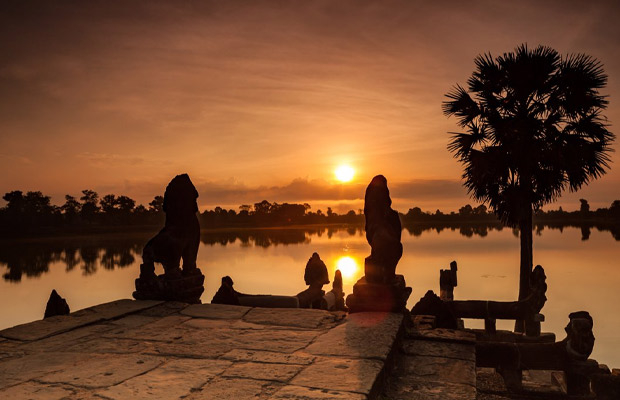
Srah Srang is a small but quite picturesque baray (ancient Khmer reservoir), located to the east of Banteay Kdei. It was designed and constructed in the same mountain-temple style as Pre Rup and was remodelled in the 12th century by King Jayavarman VII as part of his building program.
This 10th Century baray, or reservoir, is a magical setting for its visitors, who admire a serene sunrise from its cross-shaped, laterite landing stage. Under the watchful eye of two lion guardian statues, enjoy the view of the baray, which has remained at least partially flooded since its heyday in King Rajendravarman II’s rule.
Although the name suggests its purpose was for royal bathing, inscriptions found on the site, dating back to the mid-10th Century, point to a more inclusive intention – providing water ‘for the benefit of all creatures’.
The possibility that there was once a temple built on an artificial island in the centre of the 700m x 300m reservoir was discovered when stones, similar to those used for East Mebon, were found. Changes to the structure of Srah Srang occurred in the 12th Century when Jayavarman VII added a terrace to its western side and lined the pond with sandstone. The additions to the original structure are likely to have coincided with the East Baray having accumulated sediment, causing it to cease functioning efficiently. An alternative source of water for the population would have been required – Srah Srang being a convenient choice.
Srah Srang has all the elements of a romantic setting, with its surrounding greenery, its grand landing stage and sweeping views across the water, reflecting a sunrise or a setting sun. Serpent balustrades that lead down to the water from the platform are flanked by two majestic lions. Visitors will also find a large garuda riding a three-headed serpent, which rests on a platform along with other mythical creatures. The Bayon-style architecture so favoured at the time, was the work of King Rajendravarman’s preferred architect, Kavindrarimathana.
A majestic platform (landing stage) with leads to the pond. It is built of laterite with sandstone molding. The platform is in the shape of a cross with serpent balustrades flanked by two lions. At the front there is an enormous Garuda riding a three-headed serpent. At the back there is a mythical creature comprising a three-headed serpent, the lower portion of a Garuda and a stylized tail decorated with small serpent heads. The body of the serpent rests on a dais supported by mythical monsters. See map page 70.
Located 1km south of the East Baray and east of Banteay Kdei, the terrace is accessed via steps from the road, which lies at a lower level than the baray’s banks, affording a view across the water as you approach.
Sunrise is a popular time to visit Srah Srang, as it offers a peaceful alternative to the crowded Angkor Wat.
The tiny 12th-century Buddhist temple of Neak Pean (sometimes written Neak Poan or Neak Poun sits on a circular stone island in a square pool, framed by four more pools, all built on an island in the middle of a lake. The temple’s name means “entwined serpents.”
A favorite Angkor sunset spot, Pre Rup is a 3-tier mountain temple topped with five sanctuary towers. Built in 961 AD as a temple to the Hindu god Shiva, Pre Rup’s name means “turn the body,” and some believe it was used for cremations. Its warm brickwork and red laterite stone look beautiful at sunrise or sunset.
The sprawling temple complex of Angkor Thom, an ancient Khmer capital formerly ringed by a crocodile-infested moat, surpasses the world-famous Angkor Wat in both size and scale. Each of the site’s five gates are heralded by avenues lined with 108 deities that represent good and evil, which provide spectacular photo opportunities before you even step inside.
The Siem Reap Art Center Night Market is open from morning until late in the evening, but it is more of a night market than an art center. Close to the Old Market (Phsar Chaa or Phsar Chas), the site boasts a wealth of stalls selling crafts, souvenirs, the obligatory elephant pants, and snacks.
© 2024, Angkor Discovery Tours. All Rights Reserved.
Our team of passionate guides are here would love to hear from you.

Srah Srang (The Royal Bath)